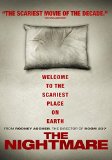| Reviews & Columns |
|
Reviews DVD TV on DVD Blu-ray 4K UHD International DVDs In Theaters Reviews by Studio Video Games Features Collector Series DVDs Easter Egg Database Interviews DVD Talk Radio Feature Articles Columns Anime Talk DVD Savant Horror DVDs The M.O.D. Squad Art House HD Talk Silent DVD
|
DVD Talk Forum |
|
|
| Resources |
|
DVD Price Search Customer Service #'s RCE Info Links |
|
Columns
|
|
|
Nightmare, The
The Nightmare is noteworthy for being perhaps the only documentary to explore the phenomenon of sleep paralysis, a half-conscious state in which people who are trapped within its grip experience nightmarish sensations that involve the nearly complete inability to move one's body, constricted breathing, and scarily, the presence of what the interviewees in the film describes as three-dimensional shadow beings. The film is visually arresting in the way that many great films that explore subconscious states are, like David Lynch's Mulholland Drive and many experimental short films that have been made over the decades.
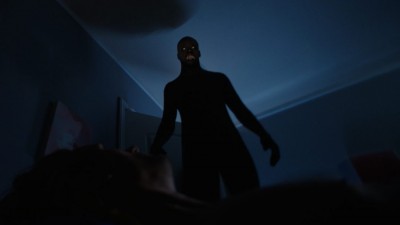 The film strikes a personal note for me because I have experienced sleep paralysis in my youth, and many of the experiences recounted in the nightmare are eerily similar to those of my own. I too have woken in the middle of the night, feeling as though I were trapped inside my own body like a quadriplegic, my breathing constricted to the point that it felt as though there were hands inside my chest, tightly gripping my lungs. And similar to the many stories recounted in The Nightmare, I too have seen terrifying visions of shadow people while stuck inside this seemingly half-conscious state. The Nightmare speaks to me on a personal level because, like few films I've ever seen during my entire life, it directly shows in visual terms some of the experiences I've had as a frightened kid who woke up in the middle of the night to be visited by tall, pitch black figures who held a strange power over my body and my psyche. Experiencing sleep paralysis and its oddly shared symptoms among people from disparate backgrounds is all the more frustrating, isolating, and scary, because, as many of the interviewees in the film describe, this terrifying subconscious state is often brushed off by professionals as a easily treatable state that can be adjusted by generic "lifestyle changes."
The film strikes a personal note for me because I have experienced sleep paralysis in my youth, and many of the experiences recounted in the nightmare are eerily similar to those of my own. I too have woken in the middle of the night, feeling as though I were trapped inside my own body like a quadriplegic, my breathing constricted to the point that it felt as though there were hands inside my chest, tightly gripping my lungs. And similar to the many stories recounted in The Nightmare, I too have seen terrifying visions of shadow people while stuck inside this seemingly half-conscious state. The Nightmare speaks to me on a personal level because, like few films I've ever seen during my entire life, it directly shows in visual terms some of the experiences I've had as a frightened kid who woke up in the middle of the night to be visited by tall, pitch black figures who held a strange power over my body and my psyche. Experiencing sleep paralysis and its oddly shared symptoms among people from disparate backgrounds is all the more frustrating, isolating, and scary, because, as many of the interviewees in the film describe, this terrifying subconscious state is often brushed off by professionals as a easily treatable state that can be adjusted by generic "lifestyle changes."
The documentary ties together the experiences of eight people who have experienced sleep paralysis, and tries to underline the fact that each subject comes from a background that is different from the other participants. While this is true in some ways, it has to be noted that nearly all of the people whose experiences are recounted in the film, with the exception of a man from England, are American, and that every participant's perspective is tinged by Western thought -there are explanations of sleep paralysis briefly mentioned from other cultures that explain it in terms of evil spirits, but this casts non-American, non-Western views of sleep paralysis as that of an "other" point of view. There is an Asian American woman in the film who laughed in the face of a person who suggested that seek religion before her experiences with sleep paralysis drove her to Christianity. Such a limited cultural perspective for one of the most terrifying sleep disorders simply leaves the film with an unexplained phenomenon interpreted through the modern pop culture lens of horror film visual conventions, along with clips from Nightmare of Elm Street, Jacob's Ladder, the sci-fi film Communion, and the terrible film Insideous. The film wishes to show sleep paralysis as a kind of horror movie that the interviewees experience, devoid of any spiritual, or even psychological, meaning.
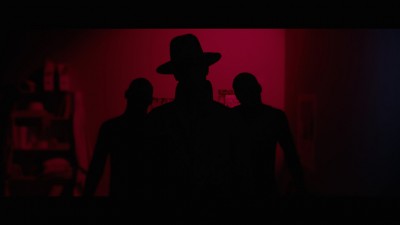 Despite such a limited perspective about sleep paralysis and what it could possibly mean, the film works on a visual level by conveying the distinct dread that courses through one's body when gripped by unseen forces. In a literal sense, the film re-enacts the experiences of those who awaken trapped inside their own bodies while they are being watched over by dark, menacing figures. Within the surface-level expression of such dark forces, the experiences of each participant varies slightly. In the beginning of the film, an interviewee named Chris relates his first experiences with sleep paralysis as a five year old when he recounts the story of watching a newscast and becoming frightened when the newscaster addresses him directly and essentially inducts him into the darker moments that will plague him throughout much of his life.
Despite such a limited perspective about sleep paralysis and what it could possibly mean, the film works on a visual level by conveying the distinct dread that courses through one's body when gripped by unseen forces. In a literal sense, the film re-enacts the experiences of those who awaken trapped inside their own bodies while they are being watched over by dark, menacing figures. Within the surface-level expression of such dark forces, the experiences of each participant varies slightly. In the beginning of the film, an interviewee named Chris relates his first experiences with sleep paralysis as a five year old when he recounts the story of watching a newscast and becoming frightened when the newscaster addresses him directly and essentially inducts him into the darker moments that will plague him throughout much of his life.
The Nightmare shows that sleep paralysis, shadow people, and the Hat Man are embedded not only in the collective unconscious of dreamers, but also in the popular culture we consume, most notably, in the form of horror films. Comparing the phenomenon of sleep paralysis to popular culture, one man recounts first seeing the shadow beings from sleep paralysis lore as a one year old and describing them as the lanky, bug-eyed figures that fit common descriptions of "grey aliens." Here, we are shown a clip of Christopher Walken encountering the grey aliens in the film Communion. In a similar way, we are introduced to clips of Wes Craven's Nightmares on Elm Street, one of which shows the silhouette of Freddy Kruger's signature hat in a way that resembles the "Hat Man" phenomenon associated with sleep paralysis, where hatted figures are often seen.
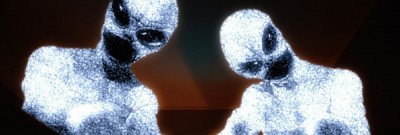 The deep blacks, blues and reds that bathe the reenactments imbue the film with a uniquely eerie tone that does a surprisingly good job of conveying the terrifying feeling of falling into the throes of sleep paralysis. The three-dimensional shadow people and other enigmatic dream figures are given the weight often felt when being confronted by figured from a nightmare. Of particular note, one participant in the documentary recounts an elaborate dream in which he is stalked by a large, overweight man with bright orange hair who wears combat fatigues. On its surface, the image of a fat man wearing an orange wig and ill-fitting military garb appears silly, but, then again, something as out of place as this particular figure has its own terrifyingly out-of-place nature that is horrifying in the same way that clowns are unintentionally scary. And so goes the nature of nightmares and illogical dream states in general.
The deep blacks, blues and reds that bathe the reenactments imbue the film with a uniquely eerie tone that does a surprisingly good job of conveying the terrifying feeling of falling into the throes of sleep paralysis. The three-dimensional shadow people and other enigmatic dream figures are given the weight often felt when being confronted by figured from a nightmare. Of particular note, one participant in the documentary recounts an elaborate dream in which he is stalked by a large, overweight man with bright orange hair who wears combat fatigues. On its surface, the image of a fat man wearing an orange wig and ill-fitting military garb appears silly, but, then again, something as out of place as this particular figure has its own terrifyingly out-of-place nature that is horrifying in the same way that clowns are unintentionally scary. And so goes the nature of nightmares and illogical dream states in general.
The Nightmare's attempt to Draw parallels to the horror genre almost cheapens the occurrence of one of the last fully examined psychological conditions involving sleep and the subconscious. Where does sleep paralysis come from, exactly, and what causes it? The film doesn't care to answer such questions, but that isn't necessarily a weakness in its narrative. However, in place of a serious examination of any possible causes of sleep paralysis, we are forced to view its occurrence strictly through the already-tired conventions of the horror genre. This particular mode is helpful for those who have never experienced sleep paralysis, as a way of conveying the sense of terror and dread that accompany it, but it also runs the risk of de-legitimizing it as a false state simply influenced by all of the pop culture we consume. A better parallel would have been to the dream-like state that film in general induces, rather than to the medium's least inspired genre.
As a kid who woke up one night and felt the heavy sense of dread exuding from the black, hatted shadow figure watching him from the corner of his darkened bedroom, sleep paralysis represents more than the facile, often cheap thrills we experience through horror films. Watch The Nightmare for its atmospheric reenactments, but look beyond its facile treatment of the condition as a similar experience to watching a horror film. Everyday terror is far scarier than any horror film.
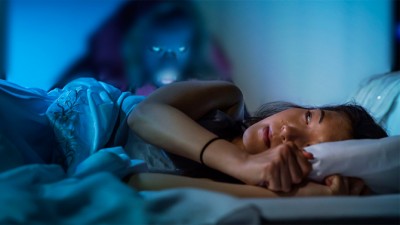 The DVD:
The DVD:
Video: The Nightmare DVD is shown in its original 2.35:1 aspect ratio. The beautiful, cool colors are dark and well balanced, particularly in the dimly lit reenactments, where bedside lamps, flickering TV screens, moon light, and street lights are used to convey the eerie tone of the film. Much of the film has a dark color pallet, and works quite well when achieving its dreamy feel. The Nightmare may good be a good case study for exploring the ways film lighting can be used to convey certain dreadful moods.
Audio: The Stereo Surround soundtrack envelopes the viewer during the moments when ambient sounds rise, usually when the shadow people make their appearances in the reenactments. Low rumbles, TV static, and the horror-inspired musical score add to the general tone of terror that the documentary wishes to convey.
Extras: The DVD contains the original theatrical trailer, along with a trailer edited by the film's director, Rodney Ascher, which doesn't particularly deviate much from the official version. In fact, the official trailer released by the film's distributor does a better job of encapsulating its experience.
There are three deleted scenes containing extended interview footage with three of the film's participants. These deleted scenes are very brief, but one in particular stands out. Chris, whose experience of being spoken to through his television as a child opens the film, intensely describes the time warp that occurs during his sleep paralysis episodes. Oddly, he compares the warping of time during his sleep paralysis episodes to the film Taxi Driver being superimposed over Jurassic Park. Chris is the most intense interviewee in The Nightmare, and his experiences are deeply felt. His sleep paralysis problem has haunted him his entire life, and in one moment of the film he describes leaving a television on a static-y channel to ward off the dark figures that visited him at night. As he found that this worked in staving off the nightmares that plagued him, he began using more and more televisions to ward them off, until they were all stacked together in his room. The deleted scene enhances the viewing experience to add further dimension to the portrayal of Chris as an intense young man more deeply affected by sleep paralysis than the other participants in the film.
Final Thoughts:
The Nightmare is the first documentary to fully explore the sleep paralysis phenomenon, and it does so in a visually stunning manner through its reenactments. As a person who was plagued by this as-yet explained condition as a child, the film falters when it imposes a truly terrifying state with the facile conventions of the horror genre. The average horror film pales in comparison to the feeling of being trapped inside your own body while menacing three dimensional shadows watch you struggle against an invisible force. The Nightmare doesn't provide concrete explanations for sleep paralysis, but this isn't a weakness. Watch it for the truly convincing sense of dread in its reenactments. Lull yourself into a cinematic dreamstate.
|
| Popular Reviews |
| Sponsored Links |
|
|
| Sponsored Links |
|
|
| Release List | Reviews | Shop | Newsletter | Forum | DVD Giveaways | Blu-Ray | Advertise |
|
Copyright 2024 DVDTalk.com All Rights Reserved. Legal Info, Privacy Policy, Terms of Use,
Manage Preferences,
Your Privacy Choices | |||||||









